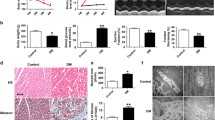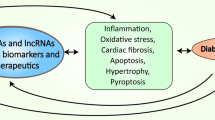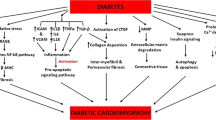Abstract
Prevalence of diabetes mellitus (DM), a multifactorial disease often diagnosed with high blood glucose levels, is rapidly increasing in the world. Association of DM with multi-organ dysfunction including cardiomyopathy makes it a leading cause of morbidity and mortality. There are two major types of DM: type 1 DM (T1D) and type 2 DM (T2D). T1D is diagnosed by reduced levels of insulin and high levels of glucose in the blood. It is caused due to pancreatic beta cell destruction/loss, and mostly found in juveniles (juvenile DM). T2D is diagnosed by increased levels of insulin and glucose in the blood. It is caused due to insulin receptor dysfunction, and mostly found in the adults (adult DM). Both T1D and T2D impair cardiac muscle function, which is referred to as diabetic cardiomyopathy. We and others have reported that miRNAs, a novel class of tiny non-coding regulatory RNAs, are differentially expressed in the diabetic heart and they contribute to diabetic cardiomyopathy. Here, we elaborated the biogenesis of miRNA, how miRNA regulates a gene, cardioprotective roles of different miRNAs including miRNAs present in exosomes, underlying molecular mechanisms by which miRNA ameliorates diabetic cardiomyopathy, and the role of miRNA as a potential therapeutic target for juvenile and adult diabetic cardiomyopathy.
Access this chapter
Tax calculation will be finalised at checkout
Purchases are for personal use only
Similar content being viewed by others
References
King H, Aubert RE, Herman WH (1998) Global burden of diabetes, 1995–2025: prevalence, numerical estimates, and projections. Diabetes Care 21(9):1414–1431
Wild S, Roglic G, Green A, Sicree R, King H (2004) Global prevalence of diabetes: estimates for the year 2000 and projections for 2030. Diabetes Care 27(5):1047–1053
Shah S, Win Z, Al-Nahhas A (2009) Multiorgan dysfunctions in diabetic patients: the role of functional imaging. Minerva Endocrinol 34(3):223–236
Gluhovschi GH, Gluhovschi C, Vlad A, Timar R, Bob F, Velciov S et al (2011) Diabetic nephropathy and multiorgan protection. Part I. Rom J Intern Med 49(3):163–177
Sardu C, Barbieri M, Rizzo MR, Paolisso P, Paolisso G, Marfella R (2016) Cardiac resynchronization therapy outcomes in type 2 diabetic patients: role of MicroRNA changes. J Diabetes Res 2016:7292564
Balakumar P, Maung UK, Jagadeesh G (2016) Prevalence and prevention of cardiovascular disease and diabetes mellitus. Pharmacol Res 113(Pt A):600–609
Ahmadizar F, Fazeli Farsani S, Souverein PC, van der Vorst MM, de Boer A, Maitland-van der Zee AH (2016) Cardiovascular medication use and cardiovascular disease in children and adolescents with type 1 diabetes: a population-based cohort study. Pediatr Diabetes 17(6):433–440
Jia G, DeMarco VG, Sowers JR (2016) Insulin resistance and hyperinsulinaemia in diabetic cardiomyopathy. Nat Rev Endocrinol 12(3):144–153
Jaacks LM, Siegel KR, Gujral UP, Narayan KM (2016) Type 2 diabetes: A 21st century epidemic. Best Pract Res Clin Endocrinol Metab 30(3):331–343
Bartel DP (2004) MicroRNAs: genomics, biogenesis, mechanism, and function. Cell 116(2):281–297
Berber P, Grassmann F, Kiel C, Weber BH (2016) An eye on age-related macular degeneration: the role of microRNAs in disease pathology. Mol Diagn Ther 21:31
Abente EJ, Subramanian M, Ramachandran V, Najafi-Shoushtari SH (2016) MicroRNAs in obesity-associated disorders. Arch Biochem Biophys 589:108–119
Feinberg MW, Moore KJ (2016) MicroRNA regulation of atherosclerosis. Circ Res 118(4):703–720
Li Y, Sarkar FH (2016) MicroRNA targeted therapeutic approach for pancreatic cancer. Int J Biol Sci 12(3):326–337
Simpson K, Wonnacott A, Fraser DJ, Bowen T (2016) MicroRNAs in diabetic nephropathy: from biomarkers to therapy. Curr Diab Rep 16(3):35
Mishra PK, Tyagi N, Kumar M, Tyagi SC (2009) MicroRNAs as a therapeutic target for cardiovascular diseases. J Cell Mol Med 13(4):778–789
Zhou Y, Chen Q, Lew KS, Richards AM, Wang P (2016) Discovery of potential therapeutic miRNA targets in cardiac ischemia-reperfusion injury. J Cardiovasc Pharmacol Ther 21(3):296–309
Greco S, Fasanaro P, Castelvecchio S, D'Alessandra Y, Arcelli D, Di Donato M et al (2012) MicroRNA dysregulation in diabetic ischemic heart failure patients. Diabetes 61(6):1633–1641
Tyagi AC, Sen U, Mishra PK (2011) Synergy of microRNA and stem cell: a novel therapeutic approach for diabetes mellitus and cardiovascular diseases. Curr Diabetes Rev 7(6):367–376
Caporali A, Miscianinov V, Saif J, Emanueli C (2016) MicroRNA transport in cardiovascular complication of diabetes. Biochim Biophys Acta 1861:2111
Chavali V, Tyagi SC, Mishra PK (2014) Differential expression of dicer, miRNAs, and inflammatory markers in diabetic Ins2+/− Akita hearts. Cell Biochem Biophys 68(1):25–35
Costantino S, Paneni F, Luscher TF, Cosentino F (2016) MicroRNA profiling unveils hyperglycaemic memory in the diabetic heart. Eur Heart J 37(6):572–576
Dangwal S, Stratmann B, Bang C, Lorenzen JM, Kumarswamy R, Fiedler J et al (2015) Impairment of wound healing in patients with type 2 diabetes mellitus influences circulating MicroRNA patterns via inflammatory cytokines. Arterioscler Thromb Vasc Biol 35(6):1480–1488
Yildirim SS, Akman D, Catalucci D, Turan B (2013) Relationship between downregulation of miRNAs and increase of oxidative stress in the development of diabetic cardiac dysfunction: junctin as a target protein of miR-1. Cell Biochem Biophys 67(3):1397–1408
Zampetaki A, Kiechl S, Drozdov I, Willeit P, Mayr U, Prokopi M et al (2010) Plasma microRNA profiling reveals loss of endothelial miR-126 and other microRNAs in type 2 diabetes. Circ Res 107(6):810–817
Nandi SS, Duryee MJ, Shahshahan HR, Thiele GM, Anderson DR, Mishra PK (2015) Induction of autophagy markers is associated with attenuation of miR-133a in diabetic heart failure patients undergoing mechanical unloading. Am J Transl Res 7(4):683–696
Nandi SS, Zheng H, Sharma NM, Shahshahan HR, Patel KP, Mishra PK (2016) Lack of miR-133a decreases contractility of diabetic hearts: a role for novel cross talk between tyrosine aminotransferase and tyrosine hydroxylase. Diabetes 65(10):3075–3090
Malik ZA, Kott KS, Poe AJ, Kuo T, Chen L, Ferrara KW et al (2013) Cardiac myocyte exosomes: stability, HSP60, and proteomics. Am J Physiol Heart Circ Physiol 304(7):H954–H965
Vrijsen KR, Sluijter JP, Schuchardt MW, van Balkom BW, Noort WA, Chamuleau SA et al (2010) Cardiomyocyte progenitor cell-derived exosomes stimulate migration of endothelial cells. J Cell Mol Med 14(5):1064–1070
Das S, Halushka MK (2015) Extracellular vesicle microRNA transfer in cardiovascular disease. Cardiovasc Pathol 24(4):199–206
Prathipati P, Nandi SS, Mishra PK (2017) Stem cell-derived exosomes, autophagy, extracellular matrix turnover, and miRNAs in cardiac regeneration during stem cell therapy. Stem Cell Rev 13:79
Waldenstrom A, Ronquist G (2014) Role of exosomes in myocardial remodeling. Circ Res 114(2):315–324
Yamaguchi T, Izumi Y, Nakamura Y, Yamazaki T, Shiota M, Sano S et al (2015) Repeated remote ischemic conditioning attenuates left ventricular remodeling via exosome-mediated intercellular communication on chronic heart failure after myocardial infarction. Int J Cardiol 178:239–246
Tabak AG, Herder C, Rathmann W, Brunner EJ, Kivimaki M (2012) Prediabetes: a high-risk state for diabetes development. Lancet 379(9833):2279–2290
Karalliedde J, Gnudi L (2016) Diabetes mellitus, a complex and heterogeneous disease, and the role of insulin resistance as a determinant of diabetic kidney disease. Nephrol Dial Transplant 31(2):206–213
Bloomgarden ZT (2008) Glycemic control in diabetes: a tale of three studies. Diabetes Care 31(9):1913–1919
Mishra PK, Singh SR, Joshua IG, Tyagi SC (2010) Stem cells as a therapeutic target for diabetes. Front Biosci (Landmark Ed) 15:461–477
Rubler S, Dlugash J, Yuceoglu YZ, Kumral T, Branwood AW, Grishman A (1972) New type of cardiomyopathy associated with diabetic glomerulosclerosis. Am J Cardiol 30(6):595–602
Chavali V, Tyagi SC, Mishra PK (2013) Predictors and prevention of diabetic cardiomyopathy. Diabetes Metab Syndr Obes 6:151–160
Campos C (2012) Chronic hyperglycemia and glucose toxicity: pathology and clinical sequelae. Postgrad Med 124(6):90–97
Nguyen DV, Shaw LC, Grant MB (2012) Inflammation in the pathogenesis of microvascular complications in diabetes. Front Endocrinol (Lausanne) 3:170
Rahman S, Rahman T, Ismail AA, Rashid AR (2007) Diabetes-associated macrovasculopathy: pathophysiology and pathogenesis. Diabetes Obes Metab 9(6):767–780
Mathew V, Gersh BJ, Williams BA, Laskey WK, Willerson JT, Tilbury RT et al (2004) Outcomes in patients with diabetes mellitus undergoing percutaneous coronary intervention in the current era: a report from the Prevention of REStenosis with Tranilast and its Outcomes (PRESTO) trial. Circulation 109(4):476–480
Pignone M, Alberts MJ, Colwell JA, Cushman M, Inzucchi SE, Mukherjee D et al (2010) Aspirin for primary prevention of cardiovascular events in people with diabetes: a position statement of the American Diabetes Association, a scientific statement of the American Heart Association, and an expert consensus document of the American College of Cardiology Foundation. Diabetes Care 33(6):1395–1402
Ni R, Cao T, Xiong S, Ma J, Fan GC, Lacefield JC et al (2016) Therapeutic inhibition of mitochondrial reactive oxygen species with mito-TEMPO reduces diabetic cardiomyopathy. Free Radic Biol Med 90:12–23
Verma SK, Garikipati VN, Kishore R (2017) Mitochondrial dysfunction and its impact on diabetic heart. Biochim Biophys Acta 1863:1098
Bugger H, Boudina S, Hu XX, Tuinei J, Zaha VG, Theobald HA et al (2008) Type 1 diabetic akita mouse hearts are insulin sensitive but manifest structurally abnormal mitochondria that remain coupled despite increased uncoupling protein 3. Diabetes 57(11):2924–2932
Taye A, Abouzied MM, Mohafez OM (2013) Tempol ameliorates cardiac fibrosis in streptozotocin-induced diabetic rats: role of oxidative stress in diabetic cardiomyopathy. Naunyn Schmiedeberg’s Arch Pharmacol 386(12):1071–1080
Chen J, Mo H, Guo R, You Q, Huang R, Wu K (2014) Inhibition of the leptin-induced activation of the p38 MAPK pathway contributes to the protective effects of naringin against high glucose-induced injury in H9c2 cardiac cells. Int J Mol Med 33(3):605–612
Mishra PK, Tyagi N, Kundu S, Tyagi SC (2009) MicroRNAs are involved in homocysteine-induced cardiac remodeling. Cell Biochem Biophys 55(3):153–162
Mishra PK, Tyagi N, Sen U, Joshua IG, Tyagi SC (2010) Synergism in hyperhomocysteinemia and diabetes: role of PPAR gamma and tempol. Cardiovasc Diabetol 9:49
Prathipati P, Metreveli N, Nandi SS, Tyagi SC, Mishra PK (2016) Ablation of matrix metalloproteinase-9 prevents cardiomyocytes contractile dysfunction in diabetics. Front Physiol 7:93
Raut SK, Singh GB, Rastogi B, Saikia UN, Mittal A, Dogra N et al (2016) miR-30c and miR-181a synergistically modulate p53-p21 pathway in diabetes induced cardiac hypertrophy. Mol Cell Biochem 417(1-2):191–203
Beltrami C, Angelini TG, Emanueli C (2015) Noncoding RNAs in diabetes vascular complications. J Mol Cell Cardiol 89(Pt A):42–50
Feng B, Chen S, George B, Feng Q, Chakrabarti S (2010) miR133a regulates cardiomyocyte hypertrophy in diabetes. Diabetes Metab Res Rev 26(1):40–49
Almeida MI, Reis RM, Calin GA (2011) MicroRNA history: discovery, recent applications, and next frontiers. Mutat Res 717(1-2):1–8
Friedlander MR, Lizano E, Houben AJ, Bezdan D, Banez-Coronel M, Kudla G et al (2014) Evidence for the biogenesis of more than 1,000 novel human microRNAs. Genome Biol 15(4):R57
Hashimoto Y, Akiyama Y, Yuasa Y (2013) Multiple-to-multiple relationships between microRNAs and target genes in gastric cancer. PLoS One 8(5):e62589
Kumarswamy R, Thum T (2013) Non-coding RNAs in cardiac remodeling and heart failure. Circ Res 113(6):676–689
Okamura K, Chung WJ, Lai EC (2008) The long and short of inverted repeat genes in animals: microRNAs, mirtrons and hairpin RNAs. Cell Cycle 7(18):2840–2845
Hosoda T, Zheng H, Cabral-da-Silva M, Sanada F, Ide-Iwata N, Ogorek B et al (2011) Human cardiac stem cell differentiation is regulated by a mircrine mechanism. Circulation 123(12):1287–1296
Foshay KM, Gallicano GI (2009) miR-17 family miRNAs are expressed during early mammalian development and regulate stem cell differentiation. Dev Biol 326(2):431–443
Kuppusamy KT, Sperber H, Ruohola-Baker H (2013) MicroRNA regulation and role in stem cell maintenance, cardiac differentiation and hypertrophy. Curr Mol Med 13(5):757–764
Sartipy P, Olsson B, Hyllner J, Synnergren J (2009) Regulation of ‘stemness’ and stem cell differentiation by microRNAs. IDrugs 12(8):492–496
Gilbert PM, Havenstrite KL, Magnusson KE, Sacco A, Leonardi NA, Kraft P et al (2010) Substrate elasticity regulates skeletal muscle stem cell self-renewal in culture. Science 329(5995):1078–1081
Mishra PK, Chavali V, Metreveli N, Tyagi SC (2012) Ablation of MMP9 induces survival and differentiation of cardiac stem cells into cardiomyocytes in the heart of diabetics: a role of extracellular matrix. Can J Physiol Pharmacol 90(3):353–360
Mishra PK, Givvimani S, Chavali V, Tyagi SC (2013) Cardiac matrix: a clue for future therapy. Biochim Biophys Acta 1832(12):2271–2276
Ivey KN, Muth A, Arnold J, King FW, Yeh RF, Fish JE et al (2008) MicroRNA regulation of cell lineages in mouse and human embryonic stem cells. Cell Stem Cell 2(3):219–229
Wilson KD, Hu S, Venkatasubrahmanyam S, Fu JD, Sun N, Abilez OJ et al (2010) Dynamic microRNA expression programs during cardiac differentiation of human embryonic stem cells: role for miR-499. Circ Cardiovasc Genet 3(5):426–435
Seeger FH, Zeiher AM, Dimmeler S (2013) MicroRNAs in stem cell function and regenerative therapy of the heart. Arterioscler Thromb Vasc Biol 33(8):1739–1746
Bras-Rosario L, Matsuda A, Pinheiro AI, Gardner R, Lopes T, Amaral A et al (2013) Expression profile of microRNAs regulating proliferation and differentiation in mouse adult cardiac stem cells. PLoS One 8(5):e63041
Boon RA, Dimmeler S (2015) MicroRNAs in myocardial infarction. Nat Rev Cardiol 12(3):135–142
Crippa S, Cassano M, Sampaolesi M (2012) Role of miRNAs in muscle stem cell biology: proliferation, differentiation and death. Curr Pharm Des 18(13):1718–1729
Hodgkinson CP, Kang MH, Dal-Pra S, Mirotsou M, Dzau VJ (2015) MicroRNAs and cardiac regeneration. Circ Res 116(10):1700–1711
Kamps JA, Krenning G (2016) Micromanaging cardiac regeneration: targeted delivery of microRNAs for cardiac repair and regeneration. World J Cardiol 8(2):163–179
Lei Z, Sluijter JP, van Mil A (2015) MicroRNA therapeutics for cardiac regeneration. Mini Rev Med Chem 15(6):441–451
Peng B, Chen Y, Leong KW (2015) MicroRNA delivery for regenerative medicine. Adv Drug Deliv Rev 88:108–122
Zhu K, Liu D, Lai H, Li J, Wang C (2016) Developing miRNA therapeutics for cardiac repair in ischemic heart disease. J Thorac Dis 8(9):E918–EE27
Lai RC, Arslan F, Lee MM, Sze NS, Choo A, Chen TS et al (2010) Exosome secreted by MSC reduces myocardial ischemia/reperfusion injury. Stem Cell Res 4(3):214–222
Han C, Sun X, Liu L, Jiang H, Shen Y, Xu X et al (2016) Exosomes and their therapeutic potentials of stem cells. Stem Cells Int 2016:7653489
Bang C, Batkai S, Dangwal S, Gupta SK, Foinquinos A, Holzmann A et al (2014) Cardiac fibroblast-derived microRNA passenger strand-enriched exosomes mediate cardiomyocyte hypertrophy. J Clin Invest 124(5):2136–2146
Suzuki E, Fujita D, Takahashi M, Oba S, Nishimatsu H (2016) Stem cell-derived exosomes as a therapeutic tool for cardiovascular disease. World J Stem Cells 8(9):297–305
Iaconetti C, Sorrentino S, De Rosa S, Indolfi C (2016) Exosomal miRNAs in heart disease. Physiology (Bethesda) 31(1):16–24
Kishore R, Khan M (2016) More than tiny sacks: stem cell exosomes as cell-free modality for cardiac repair. Circ Res 118(2):330–343
Zhang B, Yeo RW, Tan KH, Lim SK (2016) Focus on extracellular vesicles: therapeutic potential of stem cell-derived extracellular vesicles. Int J Mol Sci 17(2):174
Sahoo S, Emanueli C (2016) Exosomes in diabetic cardiomyopathy: the next-generation therapeutic targets? Diabetes 65(10):2829–2831
Wang X, Gu H, Huang W, Peng J, Li Y, Yang L et al (2016) Hsp20-mediated activation of exosome biogenesis in cardiomyocytes improves cardiac function and angiogenesis in diabetic mice. Diabetes 65(10):3111–3128
Wang X, Huang W, Liu G, Cai W, Millard RW, Wang Y et al (2014) Cardiomyocytes mediate anti-angiogenesis in type 2 diabetic rats through the exosomal transfer of miR-320 into endothelial cells. J Mol Cell Cardiol 74:139–150
McClelland AD, Kantharidis P (2014) microRNA in the development of diabetic complications. Clin Sci (Lond) 126(2):95–110
Zheng D, Ma J, Yu Y, Li M, Ni R, Wang G et al (2015) Silencing of miR-195 reduces diabetic cardiomyopathy in C57BL/6 mice. Diabetologia 58(8):1949–1958
Raut SK, Kumar A, Singh GB, Nahar U, Sharma V, Mittal A et al (2015) miR-30c mediates upregulation of Cdc42 and Pak1 in diabetic cardiomyopathy. Cardiovasc Ther 33(3):89–97
Baseler WA, Thapa D, Jagannathan R, Dabkowski ER, Croston TL, Hollander JM (2012) miR-141 as a regulator of the mitochondrial phosphate carrier (Slc25a3) in the type 1 diabetic heart. Am J Physiol Cell Physiol 303(12):C1244–C1251
Chavali V, Tyagi SC, Mishra PK (2012) MicroRNA-133a regulates DNA methylation in diabetic cardiomyocytes. Biochem Biophys Res Commun 425(3):668–672
Chen S, Puthanveetil P, Feng B, Matkovich SJ, Dorn GW 2nd, Chakrabarti S (2014) Cardiac miR-133a overexpression prevents early cardiac fibrosis in diabetes. J Cell Mol Med 18(3):415–421
Kanamori H, Takemura G, Goto K, Tsujimoto A, Mikami A, Ogino A et al (2015) Autophagic adaptations in diabetic cardiomyopathy differ between type 1 and type 2 diabetes. Autophagy 11(7):1146–1160
Acknowledgements
This work was supported in part by American Heart Association Postdoctoral fellowship award 16POST30180003 to S.S.N., and the National Institutes of Health grants HL-113281 and HL-116205 to P.K.M.
Author information
Authors and Affiliations
Corresponding author
Editor information
Editors and Affiliations
Rights and permissions
Copyright information
© 2018 Springer International Publishing AG, part of Springer Nature
About this chapter
Cite this chapter
Nandi, S.S., Mishra, P.K. (2018). Targeting miRNA for Therapy of Juvenile and Adult Diabetic Cardiomyopathy. In: Mettinger, K., Rameshwar, P., Kumar, V. (eds) Exosomes, Stem Cells and MicroRNA. Advances in Experimental Medicine and Biology, vol 1056. Springer, Cham. https://doi.org/10.1007/978-3-319-74470-4_4
Download citation
DOI: https://doi.org/10.1007/978-3-319-74470-4_4
Published:
Publisher Name: Springer, Cham
Print ISBN: 978-3-319-74469-8
Online ISBN: 978-3-319-74470-4
eBook Packages: Biomedical and Life SciencesBiomedical and Life Sciences (R0)




